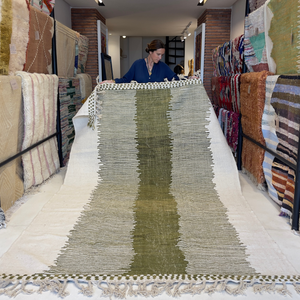Discover all Kilim rugs

Focus on the Kilim style
The Kilim rug, with its bold geometric patterns and vibrant colors, is one of the most iconic oriental textiles. Originating from the regions of Anatolia, the Caucasus, Iran and the Balkans, the Kilim is more than just a carpet: it is a tapestry of culture, history and art. Flatwoven without pile, it stands out for its lightness and flexibility, making it versatile for various uses, from floor coverings to wall hangings. Its motifs are often ancestral symbols, each shape and color having a deep meaning, whether they are motifs of protection, prosperity or love.
Timeless and elegant, the Kilim blends harmoniously with a multitude of decors, whether traditional or contemporary, bringing a touch of authenticity and exoticism to any space.

How to choose your Kilim rug?
Choosing the right Kilim rug requires both aesthetic sensitivity and attention to detail. First, identify where you want to place your Kilim. Its lightweight and versatile nature makes it suitable for a variety of spaces, whether as a floor rug, sofa throw or even wall hanging. Second, pay close attention to colors and patterns. Kilims offer a wealth of geometric patterns, each telling its own story. Select a design that complements your interior while reflecting your personal taste.
Third, consider the quality of the weave. A good Kilim is tightly woven, with straight edges and bright colors that do not bleed. Fourth, ask yourself about provenance. An authentic Kilim, designed using traditional methods, will bring this much sought-after essence of authenticity. Finally, think about maintenance. A Kilim, although robust, requires delicate care, especially when cleaning. With these elements in mind, you will be equipped to choose a Kilim rug that not only beautifies your space, but also endures over time.

Install your Kilim rug
1. Prepare the ground:
Before rolling out your Kilim rug, make sure the floor is clean and free of dirt or debris. If your floor is particularly slippery, consider using a non-slip underlay to prevent the rug from moving.
2. Determine the position:
Think about where you want the rug to be centered. Consider the surrounding furniture and make sure the rug is placed to complement the layout of the room, whether that's under a table, in the center of the room, or next to your bed.
3. Unroll:
Unroll the rug slowly and carefully. If creases have formed during transportation or storage, don't worry, they will disappear over time. To speed up this process, you can place heavy objects on the bent areas.
4. Adjust the furniture:
Once the rug is in place, readjust the furniture around it. If you place heavy furniture on the rug, this will also help to flatten any wrinkles.

Maintaining your Kilim rug
Maintaining your Kilim rug is essential to preserve its beauty and durability. Start by vacuuming it regularly to remove dust and particles. To avoid wear and tear on a particular area, consider turning it over or moving it from time to time. In the event of a stain, act quickly: dab gently with a damp cloth, avoiding rubbing so as not to embed the dirt. Use cold water to avoid bleeding colors. If necessary, use a mild wool shampoo and test it on a small, inconspicuous area first.
Avoid direct exposure to sunlight to ensure colors maintain their vibrancy. And for a thorough cleaning, it is recommended to entrust your carpet to a professional specialized in cleaning artisanal carpets. By following these tips, your Kilim rug will keep its charm and authenticity for many years.














































